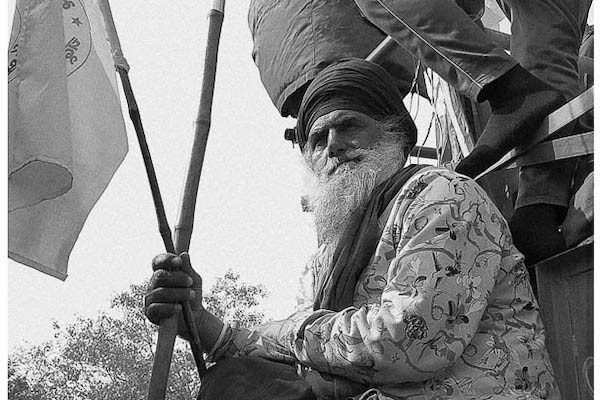‘These are portraits of farmers, not ‘thugs, parasites, terrorists, and secessionists’, as mainstream media paints them to be, not a faceless mob.
These are portraits of human beings with names, struggles, and aspirations, a way of life.
These are portraits of a class.
These are portraits of a historic protest.’
The photographs in this dossier were made by Vikas Thakur, a member of the Art Department of Tricontinental: Institute for Social Research. Based in Delhi, Vikas visited two key protest sites at the Singhu and Tikri borders on a weekly basis throughout December 2020 and January 2021. With a basic Xiaomi Note 6 phone camera in hand, he documented the farmers’ revolt. ‘At the beginning, I just wanted to snap pictures for the sake of archiving’, Vikas said. The resulting raw images are portraits of farmers–mainly coming from Haryana and Punjab–in their anger and their joy, braving the chilly winter in their tractors, reading poetry in their trolleys, and celebrating religious festivals. They are portraits of farmers, of a class, and of human beings in a historic revolt.
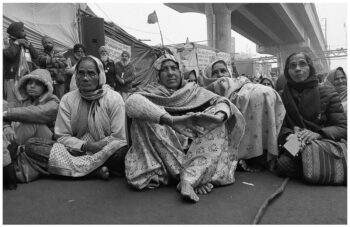
Women farmers from Punjab and Haryana protest at the Tikri border in Delhi, 24 January 2021.
Vikas Thakur / Tricontinental: Institute for Social Research
India is gripped by the second wave of the COVID-19 pandemic. The daily confirmed cases crossed 400,000 in May as the health system convulsed, hospital beds filled up, and medical oxygen canisters emptied. The spike in the death rate has created queues at crematoriums. While the spotlight is on Delhi and other urban centres, silent deaths are spreading in rural north India. People are dying of ‘fever’ and ‘breathlessness’, the common-sense terms used to describe COVID-19 symptoms. Since many have not been tested for the disease, their deaths are not part of the official numbers.
In September 2020, India’s government, led by Prime Minister Narendra Modi and his far-right Bharatiya Janata Party (BJP), passed three acts that directly impact agriculture. There was no prior consultation with farmers’ organisations and no discussion allowed in parliament. Farmers immediately perceived that these three acts would turn them into semi-serfs of the big business houses in India. They started a wave of protests that continues months later, despite the pandemic.
Farmers and agricultural workers first marched toward Delhi in November 2020. They were blocked at its borders and so set up protest encampments along the national highways. The massive mobilisations began in Punjab but soon spread to Haryana, Uttar Pradesh, Rajasthan, and Madhya Pradesh. In the weeks that followed the first marches, the protest wave spread across India, from Maharashtra in western India to Bihar in eastern India and down into south India. On Republic Day, 26 January 2021, the farmers and agricultural workers stormed New Delhi, the nation’s capital; they made it clear that the day to celebrate the Indian Constitution of 1950 was their day as well.
The corporate-controlled media vilified the farmers, attacking their integrity by calling them thugs, parasites, terrorists, and secessionists who were intent on obstructing India’s development. The farmers did not flinch. They knew that they represented their entire class, for whom this battle is existential: to accept the terms of the government’s new policy is to kill and destroy their livelihood and their way of life. They knew that the three farm acts would cede even more control over Indian agriculture to large capitalists such as the Ambani and Adani families. A range of farmers’ organisations, from All India Kisan Sabha (AIKS) to Bharatiya Kisan Union, reached out to farmers and agricultural workers across the country to build a nation-wide coalition to defend the farmers and demand the withdrawal of the three acts.
The protests have not abated, although the farmers are cautious about the pandemic. They are determined to hold fast, since the BJP government has refused to back down. Whatever the outcome, there is no doubt that Indian agriculture is poised on the edge and that the Modi government is hellbent on pushing it over that edge. The Indian peasantry continues to struggle for its survival during a chronic agrarian crisis driven by three decades of neoliberal reform. Modi’s three farm laws will decimate the remnants of the peasantry’s agrarian life and hand over the sector to corporate-controlled production and to the global supply chain.

A farmer participates in the protests in his truck at the Singhu border in Delhi, 5 December 2020.
Vikas Thakur / Tricontinental: Institute for Social Research
What is the agrarian crisis? It is a chronic condition whose symptoms are varied: the vagaries of agriculture, including crop failures, which result in low to negative incomes, indebtedness, underemployment, dispossession, and suicide. This dossier will trace the causes of this crisis, which are not hard to discern, but which go back to the days of British colonial rule and to the failures of the new Indian state after independence in 1947. Progress in Indian agriculture comes at the pace of a giant tortoise, slow-moving and stubbornly holding its course. Little seems to have changed over the past seventy-five years, and even when new factors emerge, the old ones persist. To understand why the tortoise now stops at the edge of the precipice, we have to retrace its journey.
The Past
When the English East India Company first took control of India in 1757, it began to take apart older economic relations and reorganise them to best suit tribute extraction. Different parts of India were treated differently, but the main structure of plunder remained the same. Land was turned into saleable property that could be alienated from the peasants, and newly minted intermediaries (such as Zamindars) arrived to charge exorbitant rents from the peasants. In 1770, the British stood by while Bengal, the first part of India to come under Company rule, experienced a famine that killed off a third of the population. While village society before Company rule was no paradise, during the Company and the Crown rule (after 1858), it became a living hell for the peasantry.
Economist Utsa Patnaik calculated that the Company and the British Crown extracted $45 trillion (in today’s terms) from 1765 to 1938–not even the full two centuries of colonial rule. In other words, the plunder equalled two decades’ worth of India’s current Gross Domestic Product (GDP) of $2.5 trillion.
The consequence of such severe bleeding of resources was that, even in good crop years, peasants barely had enough food to survive. In bad years–when the monsoon season failed–farmers could barely scrape together enough money to pay their taxes before lapsing into months of total starvation. Peasants could not save money or food in good years because the taxation prevented any savings. This left them vulnerable in the bad years. When drought or crop failures came, as they inevitably do, the farmers had no buffer from the atrocity of famine.
Between 1850 and 1899, Indian peasants suffered twenty-four famines, one every two years. These famines killed millions of people: during the famine of 1876-79, 10.3 million people died; during the famine of 1896-1902, 19 million people died. William Digby, a journalist who reported on the 1876 Madras famine, wrote in 1901 that when ‘the part played by the British Empire in the nineteenth century is regarded by the historian fifty years hence, the unnecessary deaths of millions of Indians would be its principal and most notorious monument’.
The memory of these famines–particularly the 1943 Bengal Famine–ensured that the new Indian state abolished taxes on the peasantry, which eliminated the slide into famine and allowed the peasantry to use their incomes to invest in their land to improve food production. During droughts, the government ensured that the peasantry received food in order to prevent the onset of famine. Hunger was not eliminated, but famine certainly was.
However, the Indian state, controlled by the big bourgeoisie and the landlords, preserved the agrarian economic hierarchies that the British had bequeathed to them. Unlike the USSR and the People’s Republic of China, independent India did not take an axe to the socio-economic hierarchies of the villages. Under pressure from the left movement, which was strong in certain regions of India, the Indian government implemented land reforms in a half-hearted manner; land redistribution was paltry and the modest ceilings on land holdings were not implemented due to the grip that landlords had on the political system in their regions. Tenancy legislation in different states had an impact, since peasants in certain states got titles to the land that they cultivated. Land concentration remained high and neo-feudal exploitation of the small peasantry and landless agricultural workers, mainly from the oppressed castes, continued.
Rather than modernise the agricultural sector, the Indian ruling class conducted public sector-led industrialisation, including building enormous dams and irrigation projects. By the end of the 1950s, India’s industrialisation hit the brick wall of unreformed agriculture. The growing industrial sector needed agricultural raw materials and the expanding industrial labour force had increased the demand for food. Consequently, food shortages had become frequent, which caused the price of food grains to inflate; this inflationary pressure slowed down industrialisation. India’s foreign exchange reserves were nearly exhausted, which constrained the ability of the government to import food grains.
By 1965, the United States had become the main exporter of food grains to India, so India’s government pleaded with the U.S. in 1956 to provide food grain under Public Law (PL) 480. Under this scheme, India imported food grains, mostly wheat, and paid the U.S. in Indian currency, which prevented India from going deeper into a foreign exchange crisis. The U.S. used the PL-480 scheme to pressure the Indian government to alter its policies, notably India’s non-aligned foreign policy. One U.S. diplomat said that the grains sent to India were of a poor quality, useful for poultry feed but not for human consumption.
Due to India’s wars with China (1962) and Pakistan (1965), foreign exchange reserves fell sharply. A drought in 1965 shrunk food production by twenty percent in the 1965-66 agricultural year. Indian politicians and diplomats pleaded the case for more grain shipments from Washington, but the U.S. sent less than needed in order to create pressure to change two policies: first, to dismantle the import substitution model of economic development and to open the country to foreign investment and trade; second, to weaken ties with the USSR and to cease criticism of the U.S. war on Vietnam. When Prime Minister Indira Gandhi went to Washington in 1966 to meet U.S. President Lyndon Johnson, she agreed to U.S. and World Bank conditions to lift import curbs, delicense a set of industries, allow U.S. investments in fertiliser production, and devalue the Indian Rupee by fifty-seven percent. As a result, inflation shot up and the economy went into a deeper crisis. India’s government believed that the U.S. would send food grains and that the World Bank would agree to a monetary package, but neither the U.S. nor the World Bank held up their end of the bargain. This was a humiliation for the Indian government, a recognition that it remained dependent on the imperialist system.
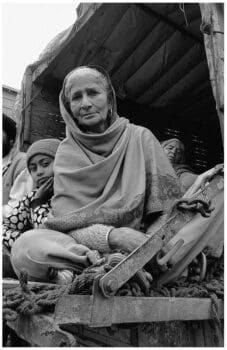
A farmer participates in a preparatory trolly rally at the Singhu border in Delhi, 7 January 2021.
Vikas Thakur / Tricontinental: Institute for Social Research
During this crisis, there was a realisation in elite circles that, for a country as large as India, feeding its people on imports was a not an option. Not only would this be an invitation for imperialist intervention in Indian sovereignty; allowing the food security of India’s millions to remain dependent on the supply and price vagaries of international markets would be a recipe for a serious internal crisis. This realisation forced the Indian government to look for internal options to attain food security and to exit the crisis.
Two Paths to Exit the Crisis
India’s government had two paths by which to exit the crisis:
- Land redistribution. India’s government could have implemented land reforms through land redistribution, which would have meant turning over land to rural landless families. The concentration of land had become an obstacle to increased agricultural productivity. Neo-feudal relations meant that landlords could extract high rents from their tenants as well as thieve free labour from the tenants for their personal use. Landlords used the rental income from the land that they leased toward moneylending rather than investing in their land and in technology. Tenants who leased the land would not use their own income to improve it, and besides the high rent ate up most of their surplus income anyway. The lack of investment in agriculture prevented high growth rates. Land redistribution, coupled with public investments in agricultural infrastructure, would have both increased socio-economic equity and economic growth. Growth would have been followed by increased productivity and increased consumption by the peasants, which would have spurred rural industrialisation.
- The Green Revolution. In the early 1960s, agronomist Norman Borlaug developed dwarf varieties of high-yielding wheat, which required chemical fertilisers and industrial-scale irrigation. This new agricultural technology of high-yielding varieties was far more productive compared to the existing indigenous technologies. Hence, the ‘Green Revolution’ was a pleasing choice for the Indian ruling class, which felt that this would raise agricultural productivity without land reform.
In fact, land reforms and Green Revolution technology need not have been seen as an exclusive choice; the combination of both, used judiciously, could have created high agricultural growth rates that benefitted the peasantry. The Indian State, however, chose to avoid reforming land relations and focused instead on the Green Revolution.
In 1961, twelve percent of the rural households owned more than sixty percent of the crop land in India’s villages. Since the government’s aim was to increase agricultural production to promote self-sufficiency in food grains in the interest of industrialisation, it made sense to implement Green Revolution technology to benefit large capitalist farmers. Improving the livelihood of the rural masses and achieving socio-economic equity were not the primary considerations. It was assumed that the benefits would trickle down to the rest of the rural households as productivity increased and as the incomes of the rich farmers grew.
To assist the farmers, the State enhanced the institutions of agronomy. It established the National Agricultural Research System along with the Indian Council of Agricultural Research (set up in 1929) at its apex along with a large network of specialised research institutions, agricultural universities, extension centres, and field research stations. These institutions provided technical support for the use of Green Revolution technologies. The high-yielding varieties required an abundance of water and the application of agrochemicals. Because of this, Green Revolution technology could only be implemented in regions with canal irrigation systems, such as Punjab, Haryana, western Uttar Pradesh, and the coastal plains of southern India. Green Revolution technology was not used in seventy percent of India’s cropland, where the villages continued to practise subsistence agriculture.
The government made substantial investments in surface irrigation to expand Green Revolution technology to the rest of the country. Between 1951 and 1991, the area under canal irrigation more than doubled, from 8.3 million hectares to 17.5 million hectares. Bank credit to farmers helped them increase irrigation by drilling tube wells and bore wells. Between 1961 and 1991, the area under tube well irrigation expanded from almost none to 14 million hectares. As canal irrigation expanded, even small and marginal farmers began to use the high-yielding seeds and chemical fertiliser combination of Green Revolution technology.
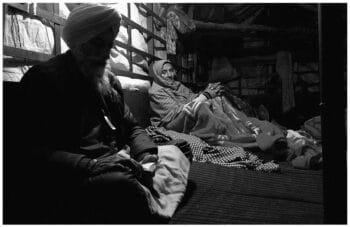
A farmer couple spends a winter night in their trolly at the Singhu border in Delhi, 28 December 2020.
Vikas Thakur / Tricontinental: Institute for Social Research
It was clear to the State institutions entrusted with agricultural development that the farmers could not be left to invest in increasing productivity by themselves. The investments needed in key areas–such as irrigation, flood control, and land development and to create market infrastructure–were considerable and were beyond the ability of individual farmers; they could only be carried out by the State. In addition, farming comes with the vagaries of nature (floods, droughts, hailstorms, and pests), further compounded by the uncertainties imposed by the capitalist system. Prices vary, with small farmers in particular unable to bargain to lower input prices and unable to control market prices of their produce. State support was needed to access credit, subsidise inputs, create a market infrastructure, and maintain a system of remunerative prices for the final output. By shouldering some of the risk through its institutional mechanisms, the State had the capacity to make farming viable. As these institutions developed in the 1960s, they became embedded in agricultural processes and in rural life. While these institutional instruments favoured the larger farmers, they nonetheless anchored the entire rural economy and provided some relief even to the landless agricultural workers. It is a testament to the resilience of these institutions that no government has been able to fully unravel them since the Indian economy began to be liberalised after 1991. Modi’s three farm laws are a direct attempt to uproot these institutional arrangements. The farmers’ struggle, therefore, is a political fight not only to protect these institutional instruments, but also to preserve their way of life.
Credit and Prices
The single most important economic policy decision in independent India was the nationalisation of banks in 1969. The need to provide credit support for agricultural expansion played an important role in this decision. Until nationalisation, the banking system in India was dominated by private banks and by the publicly controlled State Bank of India (SBI). The private banks had their offices in the metropolitan centres, with no real presence in rural India. Their boards were filled with industrialists, whose instinct was to lend money to the industrial sector and not to the agricultural sector. In 1961, agriculture–which employed seventy percent of the workforce and accounted for forty percent of the GDP–received two percent of the loans given by commercial banks. Commercial banks refused to follow any government appeal for them to lend to farmers. For commercial banks, spending money to expand into the countryside was never going to provide the same rate of return as their loans to industry and trade. As a result of the banks’ failure to invest in the agricultural sector, the State took over fourteen private banks by nationalising them in 1969 and brought eighty percent of the banking business under public control.
The government directed the newly public banks to lend at least eighteen percent of their credit to agriculture. As a result, these public banks began to open branches in rural areas, mostly in the areas where Green Revolution technology had been implemented.
For the first time, millions of peasants had an alternative to the village moneylender. This provided a boost to investment in agriculture. The banks cross-subsidised low interest loans to agriculture with profits from credit to industry and trade. Farmers received seasonal crop loans as well as long-term loans for purchasing machinery such as tractors and sprayers. Loans were given based on the size of land holding, favouring larger farmers, though farmers with smaller holdings also received credit. This credit came alongside the government’s sale of subsidised inputs such as seeds and fertilisers, and the government subsidised private fertiliser manufacturers to compensate them for the lowered prices. Bank nationalisation speeded up agricultural development.
In 1960, the government set up a Minimum Support Price (MSP) scheme; five years later, it set up the Food Corporation of India (FCI). The FCI and MSP together were meant to manage an elementary dilemma in agriculture: if food prices are too low, farmers suffer, but if food prices are too high, workers suffer. The MSP for any given crop is fixed so that farmers receive a price that covers their costs of cultivation and provides the farmer with a reasonable income. The FCI in turn procures food grains from the farmers at the MSP and makes these grains available to workers at a reasonable price. This entire mechanism is subsidised by the government, thereby balancing these competing claims. The government sells the procured food grains through a Public Distribution System (PDS) to the working class and the peasantry. Excess grain is held in the FCI godowns as a buffer in case of years of bad harvests and to use in the market as a counter-cyclical measure to shield the working class from high food inflation.
But not all of the produce cultivated by farmers is purchased by the FCI. The rest is sold to traders, who have an advantage against the individual farmers since the traders are able to underbid them, delay payments to them, and cheat them using fraudulent weighing scales. In the 1960s and 1970s, states in the Indian Union set up Agriculture Produce Marketing Committees (APMC) to regulate the market yards, create storage infrastructure at the yards, and ensure regulation of the traders’ behaviour. The FCI bought its stocks of grains at these APMC yards.
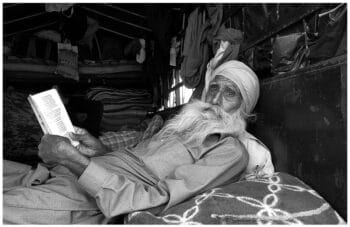
A farmer who joined in the initial protest reads work by the revolutionary Punjabi poet, Pash, in his trolly at the Singhu border in Delhi, 10 December 2021.
Vikas Thakur / Tricontinental: Institute for Social Research
The success of the government’s Green Revolution and rural credit policies were limited by its narrow objectives. These new technologies favoured states with assured irrigation, which meant that they received more of the agricultural credit. Most of the grain procurement through the MSP was limited to these regions, such as Punjab, Haryana, and western Uttar Pradesh. Even though the MSP lists only twenty-three agricultural commodities, such as cereals and pulses, rice and wheat are the most commonly purchased. The vagary of this decision means that those who farm the semi-arid regions where other crops are grown do not have access to the totality of government support. The establishment of the APMC followed this bias, so that these three regions (Punjab, Haryana, and western Uttar Pradesh) had better market infrastructure. In Punjab, there is a regulated market yard every 116 sq. km., but in Andhra Pradesh, a single market yard serves villages within 853 sq. km. The proximity of market yards makes a significant difference to small and marginal farmers since closer yards mean lower transport costs.
The Rigidities of Class
Not long after the Green Revolution began, the Indian Home Ministry quite rightly worried about the social and political consequences of deepening rural inequality. They worried, as Home Minister Y.B. Chavan put it, that the Green Revolution would likely morph into a Red Revolution. The report, The Causes and Nature of Current Agrarian Tensions (1969), that his ministry produced had a lucid assessment of the problem from a bourgeois point of view:
Firstly, [the new strategies of the Green Revolution] have rested by and large on an outmoded agrarian social structure. The interests of what might be called the agricultural classes have not converged on a commonly accepted set of social and economic objectives. Secondly, the new technology and strategy, having been geared to goals of production with secondary regard to social imperatives, have brought about a situation in which elements of disparity, instability and unrest are becoming conspicuous with the possibility of an increase in tension.
It is precisely this kind of policy that intensified rural class divisions and created the kind of work that the Home Ministry preferred to avoid, namely to tackle rural insurgencies. The ‘complex molecule’ of the Indian village, wrote the lyrical authors of the 1969 Home Ministry report, may find itself with an organised peasantry and ‘may end in an explosion’. This had to be prevented by demoralising the peasantry through debt traps and by strengthening rich peasants’ power over the countryside.
The richer peasants were in a better position to access the institutional mechanisms set up by the State. The system was set up to provide more bank credit and greater advantages of minimum support prices and subsidised fertilizer to those who had larger land holdings. Since the government was more interested in increasing agricultural productivity than in ameliorating the inequalities of rural India, the policies ended up benefitting the rich peasantry.
Since the rich farmers cornered the government bank credit, small and marginal farmers had to continue to seek loans from moneylenders. According to the latest Situation Assessment Survey of Agricultural Households, rich farmers accessed eighty percent of their loans from institutional sources, while marginal farmers got only fifty percent of their loans from these sources. For half of their credit, marginal farmers went to non-institutional sources, such as moneylenders who charged exploitatively high interest rates; this placed the marginal farmer in a debt trap. The situation remains bleak for agricultural workers, who receive eighty-eight percent of their credit from moneylenders.
Many landless and marginal farmers gain access to land by becoming tenants and leasing land from other households, often from absentee landlords. Official data underestimates the extent of tenant farming in India. Surveys show that tenant farmers constitute a significant portion of cultivator households. In some regions in coastal Andhra Pradesh, for instance, as many as seventy to eighty percent of farmers are tenants; in Bihar, twenty-six percent of cultivators are tenant farmers. Marginal peasants often add to their holdings by taking up tenancy contracts upon which they exploit their family labour.
Tenancy contracts are mostly informal oral agreements since the owners, who are absentee landlords, want to circumvent laws that give significant rights to tenant farmers in relation to the land they cultivate. As they have no title of ownership, the landless farmers–like the marginal peasants–have no access to institutional support, including crop loans or long-term loans. To access credit, these tenant farmers turn to landlords, rich peasants, moneylenders, and traders for loans. The interest rates are high, and the tenants are often forced to provide nonfinancial returns, such as free labour. When crops fail, the farmers go deeper into the debt trap. After paying the rent, incomes of small and marginal tenant farmers are so low that any shock, including health expenses or a failed crop, compels them to take informal loans, which further deepens the grip of the local creditor over their land and labour. In the absence of a tenancy contract, the tenant farmers cannot sell into the MSP system; instead, they are often forced to sell their crops at their field to traders at prices far lower than the MSP that they would receive in the regulated yards.
These problems existed before the entire credit and price system began to be undermined during the liberalisation period that began in 1991.
Liberalisation and the Agrarian Crisis
In 1990-91, the Indian government faced a serious foreign exchange crisis. The foreign exchange reserves fell to $1.2 billion, which only amounted to enough to pay for two weeks of imports. The Indian government airlifted forty-seven tonnes of gold to London as security against a short-term loan of $400 million from the Bank of London. India turned to the IMF. In November 1991, Finance Minister Manmohan Singh said, ‘Negotiations with the IMF were difficult because the world has changed. India is not immune. India has to survive and flourish in a world we cannot change in our own image. Economic relations are power relations. We are not living in a morality play’.
As some economists have pointed out, India still had other options to exit the crisis it found itself in. Instead, the Indian government chose to accept loans from the IMF and World Bank with heavy conditionalities. Under these conditionalities, India was compelled to implement neoliberal reforms under the rubric of a structural adjustment programme, which had the enthusiastic backing of both metropolitan as well as Indian capital. This reform agenda meant that government policy would cease its attempt to shield the Indian people from the worst impact of unregulated capitalism.
The government began to deregulate the banking sector by providing licenses to new private banks, which then competed against public sector banks. This had a negative impact on the agrarian system. At that time, spokespersons of liberalisation made the argument–often with little evidence–that the banking sector had suffered because of the imposition of quotas for agricultural credit, the ceiling imposed on bank interest rates for agriculture, and the creation of a network of rural bank branches. The public sector banks, finding it hard to compete with the new private banks, axed their rural divisions. Credit intended for agriculture went elsewhere, including to the slowly growing financial sector. Agricultural credit shrank and farmers once more resorted to exploitative informal credit sources.
On 1 January 1995, India joined the World Trade Organisation (WTO), which resulted in the easing of quantitative restrictions on agricultural imports. Indian farmers–many working on just a few acres of land–were forced to compete against multinational agribusinesses and against farmers from advanced industrial countries who operated on thousands of acres and received enormous subsidies from their governments.
Not only did the government open the door to agricultural imports, but it also squeezed Indian farmers by cutting subsidies. Fertiliser prices rose, which meant an increase in the costs of cultivation. Massive public relations campaigns that promised higher yields and profits by private sector firms led farmers to buy expensive seeds and pesticides, which pushed up the costs of cultivation with little corresponding increase in yields. This was evident in cotton cultivation in the semi-arid regions of Deccan Plateau; farmers had been encouraged to grow cotton to export, but the lax regulation of agribusiness led to the sale of spurious seeds and the excessive use of pesticides, which did not protect the farmers against consecutive crop failures caused by pest attacks. The fall in international cotton prices over the years triggered a serious agrarian crisis in this region with a consequent rise in farmers’ deaths by suicide. Public investment in rural areas shrank sharply. After 1991, there was no expansion in surface irrigation. The area under canals fell by a million acres due to lack of repairs and lack of desilting. As a consequence, farmers’ incomes grew by just 1.96 percent annually between 1993-94 and 2004-05.
Rising costs, low prices on the world market, and crop failures led to a period of sustained agrarian crisis. Since 1991, the government has reduced consumer food subsidies, adversely affecting the food security of millions of Indians. Between 1995 and 2001, the number of undernourished people in India increased by nearly twenty million. The UN’s Food and Agriculture Organisation’s State of Food Insecurity in the World (2003) showed that, of the 842 million undernourished people in the world at the time, 214 million, or a full quarter, lived in India. At least a quarter of a million farmers, disheartened by financial debt, committed suicide in this same decade.
The agrarian crisis is not universal: it mainly impacts small and marginal farmers. Rich farmers–who diversified into horticulture, aquaculture, etc.–have been able to buffer themselves from the full extent of the crisis by taking advantage of international markets in key sectors. They had the wherewithal to make investments and the capacity to absorb losses in bad years. Liberalisation has not been as unkind to the big farmers as it has been to the rest of agrarian society.
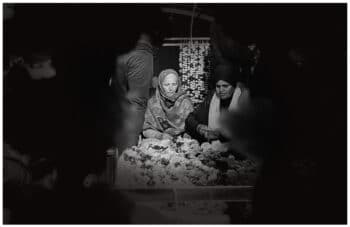
Women decorate a palki sahib, a Sikh religious structure at the Singhu border in Delhi, 31 December 2021.
Vikas Thakur / Tricontinental: Institute for Social Research
After 1991, as the negative consequences of liberalisation began to impact the field workers and the factory workers, the unemployed and the slum-dwellers, the reaction came swiftly. There was the grief of farmer’s suicides; the mass protests against the encroachment of public land, from the theft of betel vineyards to Posco Steel in Orissa; and the defence of farmland against being snatched by a Special Economic Zone in the village of Bhatta Parsaul (Noida, UP). Every state in India has experienced unrest as living standards for many have deteriorated and job prospects have remained stagnant. Lives have been torn apart to create value for the industrial and agricultural bourgeoisie and for the multinational and national firms that are linked to them. The hammer of ‘progress’ falls hard on the Adivasis (indigenous communities), whose lands are ground zero for exploitation, and on the Dalits (the oppressed castes), whose field labour is now driven by unimaginable pressures. The brutality of everyday life in today’s India does not easily translate into political activity. Social insecurity, contingent and dangerous work, fragmented communities, long-distance migration, and long daily commutes make the possibility of political action more challenging, but it also makes such action imperative.
Reprieve
In 2004, the United Progressive Alliance (UPA), a coalition led by the Congress Party, won the parliamentary election and formed the government. The UPA was backed in the parliament by the Left parties, which demanded that there be a break with the neoliberal reform agenda and that the government support the cultivators. These agreements were laid out in the Common Minimum Programme, the document outlining the coalition government’s objectives. One of its six basic principles explicitly called upon the government ‘to enhance the welfare and well-being of farmers, farm labour, and workers, particularly those in the unorganised sector, and assure a secure future for their families in every respect’.
Credit to agriculture was improved, as was public investment in rural areas. In 2005, the government introduced a rural employment guarantee programme (The Mahatma Gandhi National Rural Employment Guarantee Act or MGNREGA) that promised 100 days of work to all agricultural workers, provided funds for improvement of infrastructure in villages, and increased water tables in drought prone areas through watershed development. These programmes led to agricultural expansion, notably in the production of commercial crops such as cotton. Farmers diversified into horticultural crops and poultry to meet the demands of the urban middle class. It helped that global agricultural prices were high, that India’s GDP grew by 7-8 percent annually, and that public and private investments increased. Between 2004-05 and 2011-12, farmers’ incomes rose by 7.6 percent annually in contrast to 1.96 percent in previous years.
Despite pressure from the Left, particularly in its second term (2009-2014) when it was not dependent on the left support, the UPA government moved a neoliberal agenda in many arenas, favouring the buoyant Indian capitalist class. During its second term, the UPA proceeded to deregulate the fertilizer sector, liberalise land leases, open up agriculture to futures trading, and begin the process for agricultural market reforms. In other words, in its second term, the UPA started the process that Prime Minister Narendra Modi would accelerate.

A farmer from Haryana protests at the Tikri border in Delhi, 12 December 2020.
Vikas Thakur / Tricontinental: Institute for Social Research
India’s big capital, in close cahoots with the political class, took advantage of privatisation policies to seize public resources (including profitable public sector assets), acquire vast tracts of land by displacing village and forest communities, control the nation’s mineral resources, and undermine public sector banks through a cascading set of fraud and non-payment schemes. This process–which includes privatisation, trade liberalisation, and deflationary policies–is what Prabhat Patnaik calls ‘accumulation by encroachment’, the drive by capital to seize areas of human life with the full support of the State. From 2008 onwards, industrialist Mukesh Ambani made his annual appearance on the Forbes list of billionaires; in 2008, his net worth was $20.8 billion, and he would soon become the richest man in the world outside of Europe and North America. When the UPA government was re-elected for a second term in 2009 and could govern without Left support, the stock markets rallied to lift the market capitalisation of Ambani’s companies by $12 million in five days.
Modi’s Blight
In 2011, the largest capitalists in India–including Mukesh Ambani–attended a conclave called Vibrant Gujarat, where they praised the State’s Chief Minister Narendra Modi, set aside the accusation against him of perpetrating genocide of Muslims in 2002, and effectively endorsed Modi’s claim to become the prime minister. Eager for more neoliberal reforms, these capitalists banked on Modi as their instrument for ‘labour market liberalisation’ (i.e., cutting trade unions) and for ‘agrarian reform’. Three years later, Modi’s Bharatiya Janata Party won the parliamentary elections and became the prime minister of India.
Modi’s government was greeted with a collapse in international prices of export crops like cotton, two years of drought, and a general slowdown in agricultural growth rates. Rather than tackle the crisis that unfolded, Modi’s government inflicted three further economic disasters on the economy:
- Demonetisation (2016). By withdrawing more than eighty percent of the currency from circulation without warning, Modi forced demand to shrink, including for agricultural goods. Farmers had to throw away milk and vegetables, just as they found the cash in their hands to be worthless.
- Goods and Services Tax or GST (2017). The implementation of GST cut the small profit margins of petty traders and retail businesses. This impacted the agricultural markets, which saw a greater presence of monopoly firms in place of the more diversified petty trader sector.
- COVID-19 (2020-21). The BJP government failed to tackle the disease and its rapid spread. A sudden lockdown in March 2020 forced millions of migrant workers to walk away from their jobs in the cities and return to their homes in the villages and smaller towns. When the infection and death rate picked up, the demand for agricultural goods fell; this intensified the crisis for farmers who had no safety net.
At the onset of the COVID-19 crisis, the government took advantage of the situation to introduce three agricultural bills in parliament in June 2020, which were passed and signed into law by September 2020 without parliamentary debate. These three laws open up the agriculture sector to the entry of large agribusinesses. The government claimed that these laws would allow farmers to discover the best prices in the market, when in fact they would pit small farmers against agribusinesses, which control market information and enjoy the advantages of scale.
The three laws weaken the limited regulations that exist in the agricultural market. These regulations have been strangled since 1991, but now they are being cashiered.
- Farmers’ Produce Trade and Commerce (Promotion and Facilitation) Act. This law dictates that trade outside the regulated market yard will not be taxed, which means that traders will abandon regulated markets for unregulated ones. In the states where regulated market yards exist–such as Haryana and Punjab–this has already had an immediate impact.
- Farmers (Empowerment and Protection) Agreement on Price Assurance and Farm Services Act. This law allows agribusiness firms to enter into direct negotiation with farmers for a specific quantity of a specific crop at a specific price. There is no regulation or limit to the contract. The contracts can be oral. The law also keeps any disputes regarding these contracts out of the jurisdiction of civil courts, leaving farmers at the mercy of corporates and bureaucrats.
- Essential Commodities (Amendment) Act. Through this Act, the government removed key items (cereals, pulses, potatoes, and onions) from the list of essential commodities, which were –according to the Essential Commodities Act (1955)–not to be hoarded or speculated upon. The 1955 Act was designed to prevent food price inflation; the Amendment Act eases entry of corporates into grain trading and allows the stockpiling of agricultural goods, which accelerates market speculation.

A farmer from Punjab protests during a tractor march on Republic Day on GT Karnal Bypass Road in Delhi, 26 January 2021.
Vikas Thakur / Tricontinental: Institute for Social Research
Farmers immediately understood that these three laws meant the takeover of agriculture by big business. Already, farmers struggle to get an adequate share of their crop value: paddy farmers get less than half of what the consumer pays, and onion and potato farmers get thirty-five percent of the retail price. Once agribusiness takes over the trade, it is inevitable that farmers will see their share decrease even more.
Furthermore, farmers know that once regulated markets are shut down, the government will reduce grain procurement and may withdraw MSP altogether. The government has said that rather than subsidise fertilisers, it will provide farmers with cash transfers. Farmers say that there is a good chance that this transfer amount will not keep up with inflation, and that it will eventually be stopped. Once subsidies are cut, farmers will experience a rise in input costs, and the withdrawal of MSP will leave them to face volatile agricultural markets without support.
The justification for these laws is that subsidising fertilisers and procuring essential commodities led to the overuse of fertilisers, thereby degrading soil health, and to the overuse of ground water resources (particularly through the expansion of paddy and wheat). There is no reason to believe that big business is concerned about soil health or the overuse of water. The best solution to these problems is not to dismantle the institutions, but to reform them. For instance, farmers have long demanded that the government should expand the list of crops for procurement, thereby increasing the quantity of crops other than paddy and wheat. This would establish procurement machinery outside of areas impacted by the Green Revolution, and it would ensure a more balanced cropping pattern. By improving extension services to provide technical help, input use could be optimised. Reliance upon agrochemical companies for advice about fertilisers and pesticides has not optimised use of these chemicals. Strengthening the public extension services would go a long way in reducing the unnecessary use of harsh chemicals.
It is clear that the problem in Indian agriculture is not too much institutional support, but inadequate and uneven deployment of institutions as well as the unwillingness of these institutions to address the inherent inequalities of village society. There is no evidence that agribusiness firms will develop infrastructure, enhance agricultural markets, or provide technical support to farmers. All this is clear to the farmers.
The farmers’ protests, which began in October 2020, are a sign of the clarity with which farmers have reacted to the agrarian crisis and to the three laws that will only deepen the crisis. No attempt by the government–including trying to incite farmers along religious lines–has succeeded in breaking the farmers’ unity. There is a new generation that has learned to resist, and they are prepared to take their fight across India.
Professor Sarbjot Singh Behl, who teaches at Guru Nanak Dev University (Amritsar, Punjab), wrote a poem, Tale of a Farmer (translated by Jeena Singh), which captures the farmers’ fighting spirit:
Till, sow, plough and reap
Are the promises I keep
To the good earth beneath my feet
Such is life…
Till the last breath this body breathesThe soil I watered with my sweat
Storms I weathered on my chest
Biting cold or summer heat
Could never make my spirit retreat
Such is life…
Till the last breath this body breathesWhat nature could not, the ruler did
Put my spirit’s effigy
Like a scarecrow in fields of plenty
For his mirth and mockery
Such is life…
Till the last breath this body breathesIn days gone by, my fields were spread
Where heavens with the earth met
But alas! Now I’m only left
With a couple of acres to pay my debt
Such is life…
Till I breathe my last breathMy harvest gold, white, and green
I bring to market hopes umpteen
Dashed hopes and empty hands
Are the gifts of my lands
Such is life…till death agrees
To put me out of this miseryChildren whine, unfed, unlettered
Their dreams now lie scattered
Under the roof, just debris
Bodies broken, souls shattered
Such is life…
Till the last breath this body breathesAll the gems, jewelry gone,
Empty stomachs, souls forlorn
But I have promises to keep
To quell the hunger and the greed
Such is life…
Till the last breath this body breathesThe golden harvest that I reap
No merchant ever wants to keep
Debt ridden, in distress so deep
My leaden heart can hardly beat
Such is life…
Till the last breath this body breathesCan there be another solution?
It’s either noose or revolution
Sickle and scythe no longer tools
But are now arms indeed
Such is life…
Till the last breath this body breathes
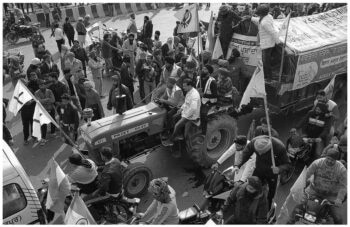
A tractor contingent on GT Karnal Road breaks through barricades and enters Delhi, beginning a confrontation between protestors and the police in Delhi, 26 January 2021.
Vikas Thakur / Tricontinental: Institute for Social Research
References:
Balachandran, Gopalan. Reserve Bank of India, 1951-1967, Vol. 2. Oxford: Oxford University Press, 1998.
Bansal, Vaishali, Yoshifumi Usami, and Vikas Rawal. Agricultural Tenancy in Contemporary India: An Analytical Report and a Compendium of Statistical Tables based on NSSO Surveys of Land and Livestock Holding, SSER Monograph 18/1. New Delhi: Society for Social and Economic Research, 6 May 2018.
Bardhan, Pranab. ‘Green Revolution and Agricultural Labourers’. Special issue of Economic and Political Weekly, vol. 5, no. 29-31, July 1970.
Bhaduri, Amit. ‘A Study in Agricultural Backwardness Under Semi-Feudalism’. The Economic Journal, vol. 83, no. 329, 1 March 1973.
Bhoi, Binod B., Sujata Kundu, Vimal Kishore, and D. Suganthi. ‘Supply Chain Dynamics and Food Inflation in India’. RBI Bulletin, vol. LXXIII, no. 10, October 2019.
Chakravarti, A. K. ‘Green Revolution in India’. Annals of the Association of American Geographers, vol. 63, no. 3, September 1973.
Chand, Ramesh, Raka Saxena, and Simmi Rana. ‘Estimates and Analysis of Farm Income in India, 1983–84 to 2011–12’. Economic and Political Weekly, vol. 50, no. 22, May 2015.
Chaudhary, M. K., and D. R. Aneja. ‘Impact of Green Revolution on Long-Term Sustainability of Land and Water Resources in Haryana’. Indian Journal of Agricultural Economics, vol. XLVI, no. 3, July-September 1991.
Davis, Mike. Late Victorian Holocausts: El Niño Famines and the Making of the Third World. New York: Verso, 2000.
Digby, William. ‘Prosperous’ British India: A Revelation from Official Records. London: Fisher Urwin, 1901.
Dutt, Subimal. Report of the Industrial Licensing Policy Inquiry Committee. Government of India, Ministry of Industrial Development, Internal Trade and Company Affairs, New Delhi, 1969.
Gait, E. A. Census of India, 1911, Vol. 1. Calcutta: Office of the Superintendent Government Printing, 1911.
George, P. S. ‘Some Aspects of Public Distribution of Foodgrains in India’. Economic and Political Weekly, vol. 19, no. 39, 29 September 1984.
Ghosh, Jayati, C. P. Chandrasekhar, and Prabhat Patnaik. Demonetisation Decoded: A Critique of India’s Currency Experiment. New Delhi: Routledge India, 2017.
Goldsmith, Arthur A. ‘Policy Dialogue, Conditionality, and Agricultural Development: Implications of India’s Green Revolution’. The Journal of Developing Areas, vol. 22, no. 2, January 1988.
Government of India, Directorate of Economics and Statistics, Ministry of Agriculture, Cooperation, and Family Welfare. Pocket Book of Agricultural Statistics 2017. New Delhi, 28 June 2018.
Government of India, Ministry of Agriculture and Farmers’ Welfare. Report of the Committee on Doubling Farmers’ Income, Volume I: ‘March of Agriculture since Independence and Growth Trends’. New Delhi, August 2017.
Government of India, Ministry of Statistics and Programme Implementation. ‘Summary of macro economic aggregates at current prices, 1950-51 to 2013-14’. New Delhi, March 2014.
Government of India, National Sample Survey Office, Department of Statistics and Programme Implementation. Key Indicators of Situation of Agricultural Households in India. NSS 70th Round, January-December 2013, New Delhi, December 2014.
Government of India, Research and Policy Division, Ministry of Home Affairs. The Causes and Nature of Current Agrarian Tensions. New Delhi, 1969.
Government of India, National Sample Survey Organisation, Department of Statistics. Tables with notes on some aspects on landholdings in rural areas (state and all-India estimate). NSS 17th Round, September 1961-July 1962, Report no. 144, New Delhi, 1970.
Government of India, Ministry of Information and Broadcasting. Problems of the Third Plan: A Critical Miscellany. New Delhi, 1961.
Hazari, R. K. Corporate Private Sector: Concentration, Ownership and Control. Bombay: Asia Publishing House, 1966.
Issac, T.M., Thomas, Lekha Chakraborty, and R. Mohan. Challenges to Indian Fiscal Federalism. Foreword by Ghosh, Jayati, and C.P. Chandrasekhar. New Delhi: LeftWord Books, 2019.
Mooij, Jos. ‘Food policy and politics: The political economy of the public distribution system in India’. Journal of Peasant Studies, vol. 25, no. 2, 1998.
McMahon, Robert J. ‘Food as a Diplomatic Weapon: The India Wheat Loan of 1951’. Pacific Historical Review, vol. 56, no. 3, August 1987.
Patnaik, Prabhat, and C. P. Chandrasekhar. ‘Indian Economy under ‘Structural Adjustment’. Economic and Political Weekly, vol. 30, no. 47, November 1995.
Patnaik, Prabhat. ‘The Accumulation Process in the Period of Globalisation’. Economic and Political Weekly, vol. 43, no. 26-27, 28 June-11 July 2008.
Patnaik, Utsa, and Subhra Chakrabarti, eds. Agrarian and Other Histories: Essays for Binay Bhushan Chaudhuri. New Delhi: Tulika Books, 2019.
Ramachandran, V. K., Madhura Swaminathan, and Vikas Rawal, eds. Socio-economic Surveys of Three Villages in Andhra Pradesh: A Study of Agrarian Relations. New Delhi: Tulika Books, 2010.
Ramana Murthy, R.V., and Rekha Misra. ‘Pricing of Paddy A Case Study of Andhra Pradesh’. Reserve Bank of India, Department of Economic and Policy Research, Development Research Group, Study no. 38, 2012.
Ramakumar, R., ed. Note-Bandi: Demonetisation and India’s Elusive Chase for Black Money. Oxford: Oxford University Press, 2018.
Rawal, Vikas, and Vaishali Bansal. The Land Question in Contemporary Rural India, SSER Monograph 21/2. New Delhi: Society for Social and Economic Research, 2021.
Rawal, Vikas. ‘Ownership Holdings of Land in Rural India: Putting the Record Straight’. Economic and Political Weekly, vol. 43, no. 10, March 2008.
Rawal, Vikas, Suvidya Patel, and Jessim Pais. The Political Economy of Agricultural Market Reforms: An Analysis of the Farmers Produce Trade and Commerce (Promotion and Facilitation) Act, 2020, SSER Monograph 20/4. New Delhi: Society for Social and Economic Research, 2020.
Reserve Bank of India. The Reserve Bank of India, 1967-1981, Vol. 3. Mumbai: Reserve Bank of India, 2005.
Rewa, Pranjal, ed. Kabhu na Chare Khet. Dilli ke darwaze par kisan ki dastak. New Delhi: LeftWord Books, 2021.
Shah, Mihir, Rangu Rao, and P. S. Vijay Shankar. ‘Rural Credit in 20th Century India: Overview of History and Perspectives’. Economic and Political Weekly, vol. 42, no. 15, 14-20 April 2007.
Sharma, Alakh N., and Gerry Rodgers. ‘Structural Change in Bihar’s Rural Economy Findings from a Longitudinal Study’. Economic and Political Weekly, vol. 50, no. 52, December 2015.
Sen, Abhijit. ‘Some Reflections on Agrarian Prospects’. Economic and Political Weekly, vol. 51, no. 8, February 2016.
Sen, Abhijit, and Jayathi Gosh. ‘Indian Agriculture after Liberalisation’. Bangladesh Development Studies, vol. XXXX, A, no. 1-2, March-June 2017.
Singh Behl, Sarbjot. ‘A Couple of Acres to Pay My Debt.’ People’s Archive of Rural India, 5 November 2020.
Singh, Gyanendra. ‘Trends in agricultural production as influenced by growth in irrigation resources in India’. World Water Policy, vol. 6, no. 2, November 2020.
Sridhar, V. ‘Why Do Farmers Commit Suicide? The Case of Andhra Pradesh’. Economic and Political Weekly, vol. 41, no. 16, April 2006.
Torri, Michelguglielmo. ‘Economic Policy and Political Gains: The First Phase of India’s Green Revolution’. Asia Studies Journal, vol. 12, no. 2-3, 1974.
Tricontinental: Institute for Social Research. CoronaShock: A Virus and the World. 5 May 2020.
Tricontinental: Institute for Social Research. The Neoliberal Attack on Rural India: Two Reports by P. Sainath. 7 October 2019.
Tricontinental: Institute for Social Research. One Hundred Years of the Communist Movement in India. 1 September 2020.

